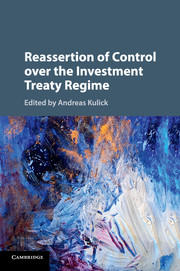Book contents
- Frontmatter
- Contents
- List of Contributors
- Preface
- PART I Introduction, Theory and Domestic Law Approaches
- PART II Procedural Aspects and Avenues of Reassertion
- PART III Substantive Aspects and Avenues of Reassertion
- 7 Masters of Puppets? Reassertion of Control through Joint Investment Treaty Interpretation
- 8 Systemic Integration: An Instrument for Reasserting the State's Control in Investment Arbitration?
- 9 Reasserting Control through Withdrawal from Investment Agreements: What Role for the Law of Treaties?
- 10 Legitimate Regulatory Interests: Case Law and Developments in IIA Practice
- 11 State Controls over Available Remedies in Investor-State Arbitration
- PART IV Reassertion of Control: Policy and Trends
- Index
8 - Systemic Integration: An Instrument for Reasserting the State's Control in Investment Arbitration?
from PART III - Substantive Aspects and Avenues of Reassertion
Published online by Cambridge University Press: 12 January 2017
- Frontmatter
- Contents
- List of Contributors
- Preface
- PART I Introduction, Theory and Domestic Law Approaches
- PART II Procedural Aspects and Avenues of Reassertion
- PART III Substantive Aspects and Avenues of Reassertion
- 7 Masters of Puppets? Reassertion of Control through Joint Investment Treaty Interpretation
- 8 Systemic Integration: An Instrument for Reasserting the State's Control in Investment Arbitration?
- 9 Reasserting Control through Withdrawal from Investment Agreements: What Role for the Law of Treaties?
- 10 Legitimate Regulatory Interests: Case Law and Developments in IIA Practice
- 11 State Controls over Available Remedies in Investor-State Arbitration
- PART IV Reassertion of Control: Policy and Trends
- Index
Summary
A. Systemic Integration under General International Law
It is only in the last two decades that the so-called principle of systemic integration became the object of scholarly and judicial debate. This is unusual, given that the principle forms part of the general rule of interpretation set out in the 1969 Vienna Convention on the Law of Treaties (VCLT). Systemic integration is an integral and indeed obligatory part of the general rule on interpretation. The unity of the rule is underlined by the International Law Commission (ILC) Commentary on the provision highlighting that ‘the provisions of the article form a single, closely integrated rule’. Notably, the principle is different from paragraphs 1 and 2 of Article 31 in that it requires the taking into account of an element extrinsic both to the text and to the context of the treaty. This is probably the reason why, unlike the other aspects of the general rule of interpretation, it is not formulated as outcome determinative. According to the ILC Commentary, the wording of Article 31(3)(c) was intended to ‘state only the broad principle and not attempt define its results’. This stands in contrast with the formulae used in Article 31(1) and (2), respectively. This is due to the extrinsic elements in paragraph 3 underlying the intention to leave much broader scope for discretion to the interpreter, further reinforced by the generality of the reference to ‘any relevant rules of international law’, also left open for determination.
The precise meaning and scope of Article 31(3)(c) remain controversial. Scholars disagree on the criteria for assessing ‘relevance’ in this context. For instance, Linderfalk favours a broad interpretation where relevant are those rules which ‘govern the state of affairs, in relation to which the interpreted treaty is examined’. Villiger constructs relevance more narrowly, as a reference to rules which ‘concern the subject-matter of the treaty term at issue’. Gardiner takes the middle ground, arguing that relevance refers to rules ‘touching on the same subject matter as the treaty provision or provisions being interpreted or which in any way affect that interpretation’. Pauwelyn adopts a functional test where a rule is relevant if it ‘sheds light on the meaning of the [treaty] term’ under interpretation. This approach is persuasive in linking relevance to the actual term of the treaty under interpretation, which is in line with the wording of the VCLT.
- Type
- Chapter
- Information
- Reassertion of Control over the Investment Treaty Regime , pp. 182 - 208Publisher: Cambridge University PressPrint publication year: 2016



